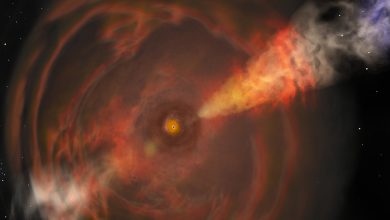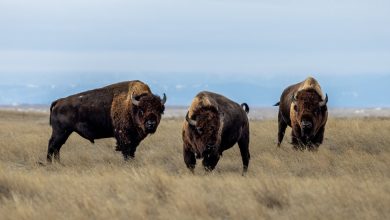The Ghost Wolves of Galveston Island

From a distance, the canids of Galveston Island, Texas, look almost like coyotes, prowling around the beach at night, eyes gleaming in the dark.
But look closer and oddities appear. The animals’ bodies seem slightly out of proportion, with overly long legs, unusually broad heads and sharply pointed snouts. And then there is their fur, distinctly reddish in hue, with white patches on their muzzles.
The Galveston Island canids are not conventional coyotes — at least, not entirely. They carry a ghostly genetic legacy: DNA from red wolves, which were declared extinct in the wild in 1980.
For years, these genes have been hiding in plain sight, tucked away in the seemingly unremarkable animals that scavenged for food behind housing developments and roamed the grounds of the local airport.
Their discovery, which came after a determined local resident persuaded scientists to take a closer look at the canids, could help revive a captive breeding program for red wolves and restore the rich genetic variation that once existed in the wild population.
“It doesn’t seem to be lost any longer,” said Bridgett vonHoldt, an evolutionary biologist at Princeton University, referring to the genetic diversity that once characterized red wolves. “We might have a chance to bring it back.”

Bridgett vonHoldt, left, an evolutionary biologist at Princeton University, and Kristin Brzeski, an environmental scientist at Michigan Technological University, looked for canids at dusk.
‘They just didn’t look right’
Ron Wooten, a Galveston resident, never paid close attention to the local coyotes until they ran off with his dog one night in 2008. “A pack took him and carried him off,” recalled Mr. Wooten, an outreach specialist at the U.S. Army Corps of Engineers.
He found the pack, and what remained of his dog, in a nearby field. He was horrified, and he blamed himself for his dog’s death. But as his flashlight swept over the coyotes’ red muzzles, he found himself fascinated.
Determined to learn more, he posted a message on Facebook asking his neighbors to alert him if they spotted the animals. Eventually, a friend came through: There was a pack near her apartment building.
Mr. Wooten raced over with his camera, snapping photographs as he watched a group of pups chasing each other. “They were just beautiful,” he said.
But when he looked more carefully at the photos, he began to wonder whether the so-called coyotes were really coyotes at all. “They just didn’t look right,” he said. “I thought at first that they must have bred with Marmaduke or something because they had super-long legs, super-long noses.”
Mr. Wooten, a former fisheries biologist, started reading up on the local wildlife and stumbled across the history of red wolves. Once abundant in the southeastern United States, the wolves had dwindled in number during the 20th century — a result of habitat loss, hunting and other threats.
In the 1970s, the U.S. Fish and Wildlife Service made a last-ditch effort to save the species, traveling along the Gulf Coast and trapping all the red wolves it could find. Scientists selected some of the animals for a breeding program, in hopes of maintaining the red wolf in captivity.
Mr. Wooten became convinced that the creatures that had taken his dog were actually red wolf-coyote hybrids, if not actual red wolves.
Eager to prove his hypothesis, he began looking for dead canids by the side of the road. “I was thinking that if these are red wolves then the only way they’re going to be able to tell is with genetics,” he recalled.
He soon found two dead animals, collected a small patch of skin from each and tucked them away in his freezer while he tried, for years, to pique scientists’ interest.
“Sometimes they wouldn’t respond,” he said. “Sometimes they’d say, ‘Yeah, that’s a neat animal. Nothing we can do about it.’ And, ‘They’re extinct. It’s not a red wolf.’”
Genetic secrets
Eventually, in 2016, Mr. Wooten’s photos made their way to Dr. vonHoldt, an expert on canid genetics.
The animals in Mr. Wooten’s photos immediately struck her. They “just had a special look,” she said. “And I bit. The whole thing — hook, line and sinker.”
She asked him to send his specimens, but there was a glitch: By then, he had lost one. So he packed up the skin tissue he could find and threw in the scalpel he had used to prepare the other sample, hoping that the scientists could extract DNA from it.
“It was just a really kind of lovely chaos,” Dr. vonHoldt said. (The scientists did manage to pull DNA from the scalpel, but Mr. Wooten later found the second sample and mailed that, too.)
Dr. vonHoldt and her colleagues extracted DNA from the skin samples and compared it to DNA from coyotes, red wolves, gray wolves and eastern wolves. Although the two Galveston Island canids were mostly coyote, they had significant red wolf ancestry; roughly 30 percent of their genetic material was from the wolves, they found.
“It was a real validation, I think, to the people on the ground — the naturalists and the photographers on the ground saying, ‘We have something special here,’” said Kristin Brzeski, a conservation geneticist who was a postdoctoral fellow in Dr. vonHoldt’s lab at the time. “And they do.”
Mr. Wooten was thrilled. “It blew me away,” he said.
Even more remarkable, some of the genetic variants, or alleles, the Galveston animals carried were not present in any of the other North American canids the researchers analyzed, including the contemporary red wolves. The scientists theorize that these alleles were passed down from the wild red wolves that used to roam the region.
“They harbor ancestral genetic variation, this ghost variation, which we thought was extinct from the landscape,” Dr. vonHoldt said. “So there’s a sense of reviving what we thought was gone.”
The researchers suspect that some red wolves evaded the U.S. Fish & Wildlife Service dragnet back in the 1970s. “There was surely a little slippery one that got away, or a couple,” Dr. vonHoldt said.
At some point, the red wolves or their descendants bred with local coyotes — and not just in Texas. In 2018, the same year Dr. vonHoldt’s team published its findings, another group documented high levels of red wolf ancestry in wild canids in Louisiana.
The findings could help scientists understand the genetic variation that once existed in wild red wolves and even resurrect it. “We can start actually understanding what was the historical red wolf and think about reconstructing that animal,” said Dr. Brzeski, who is now at Michigan Technological University.
In the late 1980s, some of the red wolves from the captive breeding program were released in North Carolina. But that experimental population has plummeted in recent years; officials estimate that fewer than 20 of the animals now patrol the Carolina coast. And all the red wolves alive today are descended from about a dozen animals, an extremely low level of genetic diversity that could further imperil the species.
Hybrid help
The hybrids raise new conservation possibilities. For instance, scientists might be able to restore genetic diversity by carefully breeding red wolves to hybrids with high levels of red wolf ancestry. Or they could use artificial reproductive technologies or gene-editing techniques to insert the ghost alleles back into red wolves, Dr. vonHoldt said.
The findings also come as some scientists have begun rethinking the value of interspecies hybrids. “Oftentimes, hybridization is viewed as a real threat to the integrity of a species, which it can be,” Dr. Brzeski said.
One reason that the red wolf populations declined in the wild is because the animals frequently interbred with coyotes. But, she added, “here we have these hybrids that are now potentially going to be the lifeline for the highly endangered red wolves.”
The discovery of hybrids in both Texas and Louisiana also suggests that scientists and officials may want to “refocus” their red wolf conservation efforts on those areas, said Lisette Waits, a conservation geneticist at the University of Idaho and co-author of the 2018 paper on the Louisiana hybrids.
In addition to studying the hybrids, it might make sense to reintroduce captive-bred red wolves to those regions, where animals with red wolf genes still roam the landscape. “It could completely change the direction of the red wolf recovery program,” Dr. Waits said.
Dr. Brzeski, Dr. vonHoldt and their collaborators are now studying the hybrids in both Texas and Louisiana as part of the new Gulf Coast Canine Project.
They are using GPS collars and wildlife cameras to learn more about the canids’ movements and behaviors, collecting fecal samples to analyze their diets, using genetic analysis to trace pack relatedness and collecting tissue samples from animals with the most red wolf ancestry. One goal, Dr. vonHoldt said, is to create a “biobank set of specimens that could be used to help increase the genetic health of the captive red wolf population.”
They are also hoping to learn more about how these red wolf alleles have persisted, especially in animals that live close to humans in a popular tourist destination. The island setting, which keeps the canids relatively reproductively isolated, is probably part of the explanation, but so is the “lack of persecution,” Dr. Brzeski said, noting that the animals were not commonly hunted.
Indeed, Mr. Wooten is not the only local resident who has taken an interest in the animals. The research team works closely with Josh Henderson, the animal services supervisor at the Galveston Police Department, and there is considerable community support for the canids.
Steve Parker, a lawyer who grew up in the area, remembers hearing childhood stories about his relatives trapping red wolves. The Galveston canids have helped him connect with the older generations, many of whom have passed away. “I’d like to see something and maybe be able to touch something that was special to them,” he said.
Mr. Wooten, for his part, dreams of setting up an educational center devoted to teaching the public about the unique animals. “The possibilities of what these animals hold down here is pretty valuable,” he said. “And that’s the reason I pursued it, I think. I think God was thumping me on the head and saying, ‘Hey, I got animals here. Take care of ’em.’”





